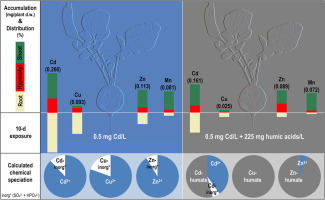Ecotoxicology and Environmental Safety ( IF 6.2 ) Pub Date : 2018-01-04 , DOI: 10.1016/j.ecoenv.2017.12.055 Gabrijel Ondrasek , Zed Rengel , Davor Romic

|
Naturally-occurring highly-complexed and polymerised organics such as humic acids (HA), due to their large negative charge, play a crucial role in biogeochemistry of trace metals (TM). Toxic (Cd) as well as essential (Zn, Cu, Mn) TM bind strongly to HA, but how these organo-metalic forms influence metal uptake by plants is poorly understood. A solution culture study was conducted to characterize the effects of different concentrations of HA (0–225 mg/L) on the growth and element uptake/distribution in roots, shoots and hypocotyls of radish (Raphanus sativus L.) exposed to Cd (0.5 mg/L) contamination. After 10-d-exposure to applied treatments, Cd induced phytotoxicity; in contrast, different concentrations of HA had no influence on biomass, but decreased concentration of most TM in examined tissues (Cu by 4.2-fold, Zn by 2.2-fold, Cd by 1.6-fold and Mn by 34%) and their total plant accumulation (Cu by 73%, Cd by 39%, Zn by 29% and Mn by 22%). HA influenced the transport/distribution of TM, decreasing accumulation in roots and increasing their translocation/deposition in shoots, with no effect on TM content in edible hypocotyls. Chemical speciation modelling of the rooting medium confirmed predominance of free metallic forms in the control (no HA) and the pronounced organo-metal complexation in the HA treatments. The results provide evidence of strong capacity of HA to decrease phytoavailability and uptake of Cd, Zn, Cu and Mn while being non-toxic even at relatively high concentration (225 mg/L). Thus, HA, as naturally present soil components, control mobility and phyto-extraction of most TM as well as their phyto-accumulation.
中文翻译:

腐殖酸可减少对痕量金属的吸收和分布,但不会降低暴露于镉中毒的萝卜的生长
天然存在的高度复杂和聚合的有机物,例如腐殖酸(HA),由于其较大的负电荷,在痕量金属(TM)的生物地球化学中起着至关重要的作用。有毒的(Cd)和必需的(Zn,Cu,Mn)TM与HA牢固结合,但是人们对这些有机金属形式如何影响植物对金属的吸收知之甚少。进行了溶液培养研究,以表征不同浓度的HA(0–225 mg / L)对萝卜(Raphanus sativus)的根,茎和下胚轴的生长以及元素吸收/分布的影响。L.)暴露于Cd(0.5 mg / L)污染。施用10天后,镉诱导了植物毒性。相反,不同浓度的HA对生物量没有影响,但降低了被检组织中大多数TM的浓度(Cu降低了4.2倍,Zn降低了2.2倍,Cd降低了1.6倍,Mn降低了34%)及其整个植物(铜73%,镉39%,锌29%,锰22%)。HA影响TM的运输/分布,减少根中的积累并增加其在芽中的转运/沉积,而对可食用下胚轴中TM的含量没有影响。生根培养基的化学形态模型确定了对照(无HA)中游离金属形式的优势以及HA处理中明显的有机金属络合。结果提供了高水平的HA降低植物利用率和对Cd,Zn,Cu和Mn吸收的能力的证据,即使在相对较高的浓度(225 mg / L)下也无毒。因此,HA作为自然存在的土壤成分,可控制大多数TM的迁移率和植物提取以及它们的植物积累。











































 京公网安备 11010802027423号
京公网安备 11010802027423号